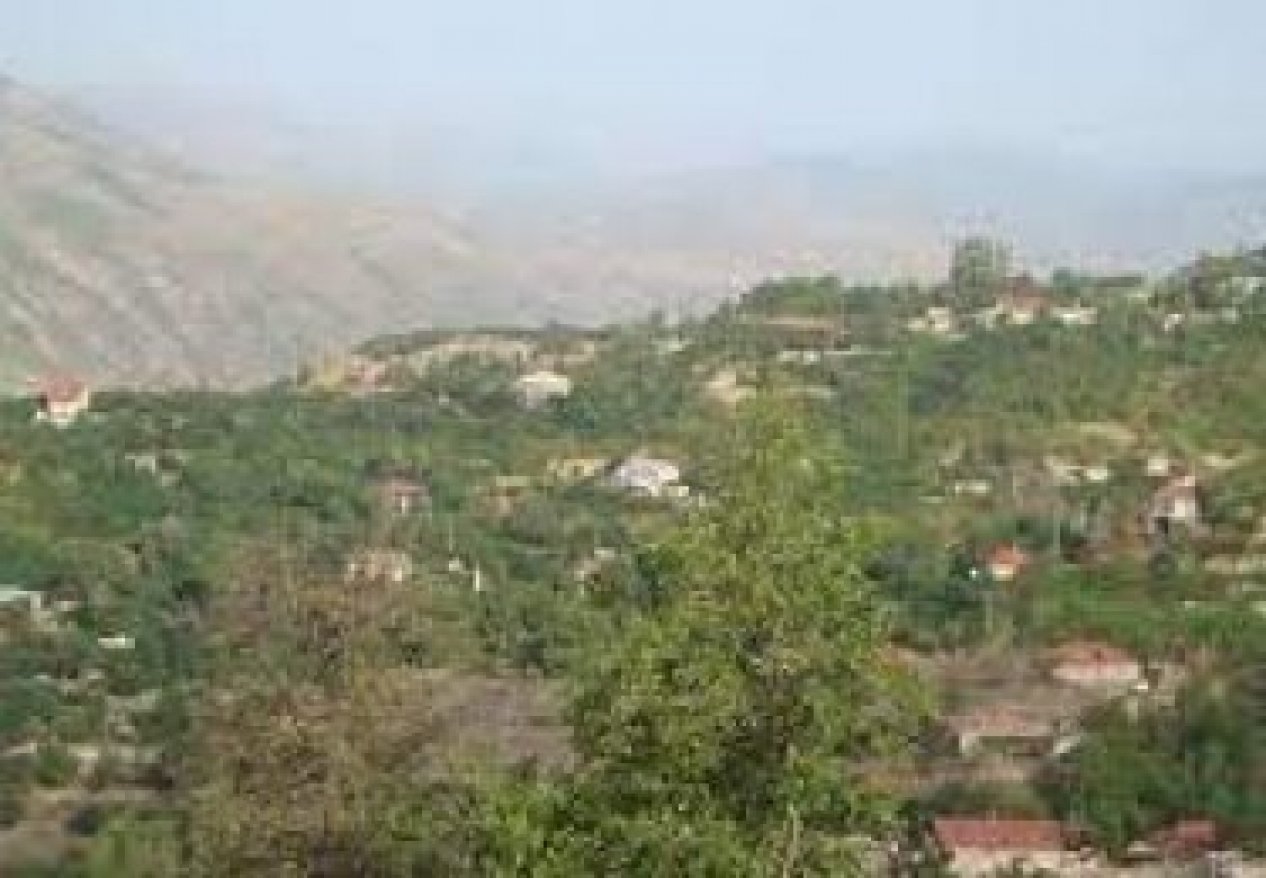
Over the past few days, rallies have been held on the territory of Azerbaijan, where peacekeeping forces are temporarily stationed, and specifically in the city of Khankandi. At these rallies, separatist-minded Armenians shout out various right-wing slogans, voice crazy ideas, and make appeals. The main idea voiced there is that "any status within Azerbaijan is unacceptable and impossible" for them. They say that "Historically Karabakh is the homeland of exclusively Armenian people" etc.
Faktyoxla Lab tried to find out if these provocative statements can be justified.
We will not delve into prehistoric times, but will study in detail the issue of power and population of Karabakh in the foreseeable period of modern history.
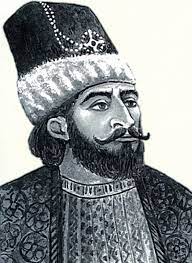
Let's start with the fact that, firstly, the founder and, later, the ruler of the Karabakh Khanate, which gained independence in 1747 after the collapse of the empire of Nadir Shah Afshar, was (according to the Soviet historian I.P. Petrushevsky) one of the prominent statesmen of Azerbaijan Panahali bey Javanshir, who consolidated his power not only in the lowland Karabakh, but also in its mountainous territory, which Armenian sources prefer to call "Artsakh".
According to historical evidence, different ethnic groups were called "Armenians" at that time, in contrast to "Hays" (the self-name of Armenians), who were subsequently resettled in the region by the Russian Empire. These are the Kipchaks, Udins and Tats, who make up a small percentage of the population of the region and were not represented in power, with the exception of the Udin meliks-vassals of the khan.
Tired of constantly being "between the hammer and the anvil" (Russia in the North and Iran in the South), the ruler of Karabakh, Ibrahim Khalil Khan, in 1805 concluded an "Oath Promise" with Russia.
The treaty between the Karabakh khanate and the Russian Empire on the transfer of the khanate under the rule of Russia was signed on May 14, 1805 in the military camp of Kurakchay, and therefore went down in history under the name "Kurekchay Treaty". It contained the obligation of Russia not to interfere in the internal affairs of the khanate.
The resettlement of ethnic hays to Karabakh took place in 1813 and 1828 after the signing of the Gulistan and Turkmanchay agreements between Russia and Iran as part of a project to create an "Armenian region" as opposed to the Turkic population, which constituted the absolute majority on the territory of the Karabakh, Nakhchivan and Erivan khanates, abolished by that time.
After the capture of Erivan during the Russian-Iranian war in 1826-1828, this plan began to be put into practice. The resettlement project was prepared by the Armenian Catholicos Nerses Ashtaraketsi. The Russian writer and diplomat A.S. Griboyedov also played an important role in the preparation and implementation of this plan. In particular, in his letter to Yegizar Lazaryan, invited from St. Petersburg to manage the resettlement of Armenians, who was then in Tabriz, Nerses asks the latter to advance the issue with the help of Griboyedov, as well as the Russian commander and diplomat Count I.F. Paskevich-Erivansky.

According to Article IV of the document, 40,000-50,000 Armenians moved to the South Caucasus from Iran.
In his letter to Count Paskevich, Griboyedov notes in particular that the Armenians are mostly settled on the lands of Muslim landlords. At the same time, as noted, most of these lands were transferred to the Armenians in the summer, when the owners were on nomad camps, where they took their cattle to.
In 1822, the Karabakh Khanate was abolished and transformed into the Karabakh province of the Russian Empire.
Subsequently, the resettlement of Armenians living in Iran, Turkiye and other countries of the East continued. In 1828-1911 alone, more than a million Armenians were brought by Russia from Iran and Turkiye and settled in the South Caucasus region, mostly in Azerbaijan.
Further, after the collapse of the Russian Empire as a result of the February Revolution of 1917, the countries of Transcaucasia Azerbaijan, Georgia and Armenia created a common republic, but it soon collapsed as well. Territorial conflicts began between them, including over Karabakh.

After the establishment of Soviet power in Transcaucasia, the plenum of the Caucasus Bureau of the Central Committee of the RCP (b) on July 5, 1921 endowed Nagorno-Karabakh with the status of autonomy, retaining it as part of Azerbaijan. Consequently, Nagorno-Karabakh, including as an autonomous region (NKAR), throughout the Soviet period, during the Armenian occupation and to this day was and remains under the jurisdiction of Azerbaijan.
Thus, as an intermediate result, we fix at least two inconsistencies in the statements of the Armenian separatists. Firstly, it is incorrect to characterize Nagorno-Karabakh as a primordially Armenian region, since historical documents show that the Armenians in it are a newcomer people, resettled since the first half of the 19th century. Secondly, this region, even after it was settled by Armenians, never had Armenian statehood, but only limited self-government, in particular, during the Soviet period under the jurisdiction of the central government of the Azerbaijan SSR.
Moreover, with regard to Zangazur, a historical region of Azerbaijan, with some changes, it covers the territories of today's Goris, Sisian, Kapan, Meghri regions of Armenia and Lachin, Gubadli and Zangilan districts of Azerbaijan. The region was renamed and administratively transformed into the Syunik province of Armenia in 1995.
The history of Zangazur, starting from the 4th century BC, is associated with several states formed in the original Turkic territories.
At the beginning of the 19th century, it was part of the Elizavetpol province of the Russian Empire, and in 1918-1920 it became one of the four counties within the Karabakh Governorate General of the Azerbaijan Democratic Republic.
After the Sovietization of Azerbaijan, the new authorities liquidated the Karabakh Governor General, creating the Karabakh Revolutionary Committee, whose powers extended within the borders of the former governorate. However, the Karabakh revolutionary committee did not control the part of Zangazur occupied by the Armenians at that time, where the detachments of Dro (Drastamat Kanayan), and later Nzhdeh (Garegin Ter-Harutyunyan), operated and carried out ethnic cleansing in Azerbaijani settlements.
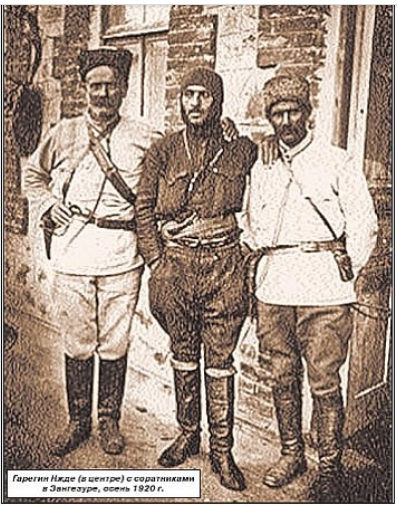
In the Azerbaijani part of the county, power was divided between the Bolshevik revolutionary committee and Sultan bey Sultanov, the brother of the former Karabakh Governor-General H. Sultanov, who was fighting with his detachment against the Armenian gangs.
By the middle of 1920, the Red Army occupied the border regions disputed between Azerbaijan and Armenia - Nakhchivan, Karabakh, and partially Zangazur.
A key role in shaping the position of Soviet Russia on the Armenian-Azerbaijani territorial conflict was played by G. Ordzhonikidze, secretary of the Caucasian Bureau of the RCP (b), who in June 1920 was entrusted with the leadership of the domestic and foreign policy of Soviet Azerbaijan by the chairman of the Council of People's Commissars V. Lenin. Thus, in fact, the Azerbaijani government headed by N. Narimanov was excluded from direct participation in the negotiations with Armenia.
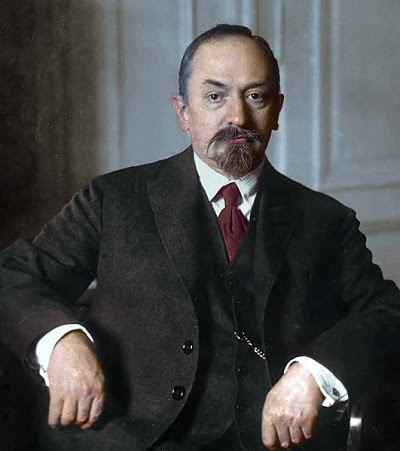
G.V. Chicherin
The strategy of Moscow in the settlement of the Armenian-Azerbaijani territorial conflict was determined in the course of active correspondence in June-July 1920 between G. Ordzhonikidze and the People's Commissar for Foreign Affairs of the RSFSR G. Chicherin.
However, considering the regional situation in the longer term and considering that a whole range of complex territorial and political issues with neighboring Turkiye were to be resolved, Chicherin advocated a compromise course towards Armenia.
As a result, by the decision of the Politburo and the Organizing Bureau of the Central Committee of the Azerbaijan Communist Party (b) of November 30 and the declaration of the Baksovet of December 1, 1920, Zangazur was completely transferred to Soviet Armenia. These decisions were enshrined in clause 3 of the agreement between the RSFSR and the Armenian SSR of December 2, 1920, by which Soviet Russia recognized the Zangazur district as indisputably part of the territory of the Armenian SSR.
The Bolsheviks pursued two goals - within the framework of the Sovietization of the South Caucasus, to achieve the loyalty of Armenia, taking into account its cooperation with the Entente, and to deprive Azerbaijan and Turkiye of direct connection through the territory of this region.
Thus, we can state that for centuries Karabakh and Zangazur belonged to the ethnic Turks and there was no "eternal" Armenian power and Armenian institutionality on these territories, with the exception of the Soviet period.
Second, in the 90s of the last century, the Armenian armed forces occupied the following territories of Azerbaijan: Nagorno-Karabakh Autonomous Oblast, Lachin, Kalbajar, Aghdam, Fuzuli, Jabrayil, Gubadli, Zangilan districts.
According to the Ministry of Emergency Situations of Azerbaijan in 2015, the number of refugees, or rather internally displaced persons, from the occupied territories of the country was 789,000.
In Lachin region, before the occupation on May 18, 1992, there were 66,671 Azerbaijanis among the population of 69,087 people.
As a result of the Armenian occupation, all Azerbaijani citizens were deported, more than 300 military and civilians were killed and went missing. In the district, 8,950 buildings were seized, including 7 industrial and construction enterprises, 471 service points, 154 schools, hundreds of monuments of history and culture.
In accordance with the tripartite statement of the presidents of Azerbaijan and Russia, as well as the prime minister of Armenia on November 9, 2020, the Lachin region came under the control of Azerbaijan on December 1 of the same year.
Kalbajar district was occupied on April 2, 1993 after several days of fighting. As a result of the occupation of Kalbajar, 511 civilians were killed by the Armenians, 321 people were captured or went missing, 58,000 people were expelled from their native lands. 130 settlements of Kalbajar came under the control of Armenia, including 97 schools, 9 kindergartens, 116 libraries, 43 clubs, 42 houses of culture, 9 hospitals, 13,000 private houses were destroyed, 37,852 hectares of forests, natural resources, including rich deposits of gold were plundered.
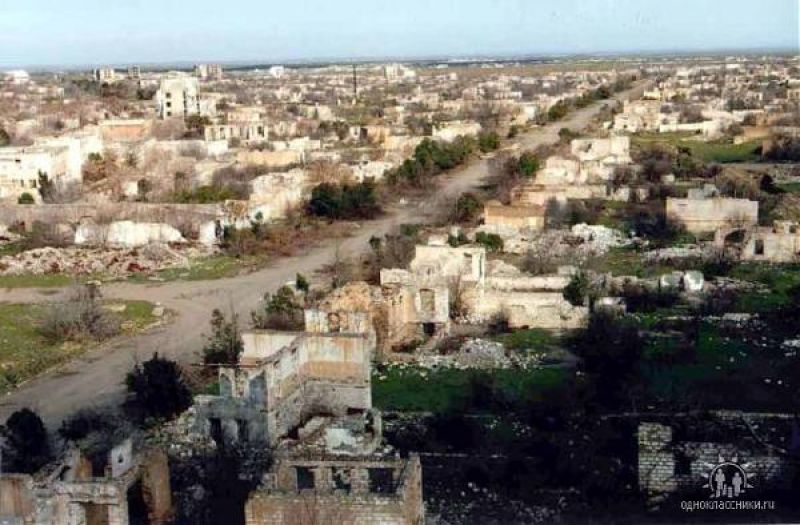
On November 20, according to the trilateral statement on Karabakh, the Aghdam region, which was partially occupied by the Armenian Armed Forces on July 23, 1993, returned under the control of Azerbaijan. Some 6,000 people were killed in battles with the enemy in Aghdam, of which 16 are National Heroes of Azerbaijan. As a result of the occupation, out of the 160,000 population of the region, 143,000 became internally displaced persons in their homeland. The Armenians captured 846.8 square kilometers, that is, 77.4 percent of the territory of the Agdam region, the total area of which is 1,094 square kilometers, turning this territory into ruins. Currently, about 90,000 people live on the territory of the district, and 101,000 people as forced migrants temporarily settled in 62 cities and regions of the country.
As a result of the capture of the Fizuli district of Azerbaijan by the Armenians on August 23, 1993, some 55,000 people were forced to leave their homes.
In January 1994, the Azerbaijani Army managed to liberate more than 12 settlements of the Fizuli region from occupation in one day. Subsequently, about 50 percent of the district's population lived on this territory.
As a result of the seizure of the neighboring Jabrayil district by the Armenians, 61 thousand people left it, 5 mosques, 2 museums, 129 historical monuments were destroyed. Azerbaijan liberated this area on October 7, 2020 during the Second Karabakh War.
The Gubadli district of Azerbaijan, a region with an area of 80,250 hectares, was occupied by Armenia on August 31, 1993. Before the occupation, according to the 1989 All-Union census, the population of the region was 28,110 people. Currently, the population of the district is about 38,000 people. The surviving residents of the district currently live in 47 regions of the country. During the defense of the region, 283 volunteers heroically died, seven of them were awarded the title of National Hero of Azerbaijan.
On October 20, 2020, Azerbaijani President Ilham Aliyev announced the liberation of Zangilan city and a number of villages of the district in his address to the nation.
As a result of the occupation of the district in 1993 by the Armenian armed forces, over 35,000 Azerbaijanis lost their homes and had to leave their native lands. During the seizure of Zangilan, 188 residents of the district were killed by the invaders, 44 people went missing, 110 became disabled, and about 200 children became orphans.
As for the NKAO, which was abolished in 1991 by the decision of the Supreme Council of the Republic of Azerbaijan, according to the 1989 census, 37,264 Azerbaijanis or 23% of the region's population lived in the Nagorno-Karabakh Autonomous Oblast. They still constituted the majority in the Shusha region (over 80%), as well as in other places of compact residence.
In general, according to the official data of the Azerbaijani side, as a result of the Armenian-Azerbaijani conflict, there are 1,138,450 refugees and internally displaced persons in the country. Of these, 350,000 are Azerbaijani refugees from Armenia.
In 1988-1993, as a result of the military aggression of the armed forces of Armenia, the number of internally displaced persons from Nagorno-Karabakh, as well as from the adjacent 7 regions, reached 788,950 people.

We see comparable figures in the materials of the Office of the UN High Commissioner for Refugees UNHCR. According to UNHCR data, as of February 2021, there are 653,921 people in the category of internally displaced persons in Azerbaijan and about 60,000 who are temporarily displaced or affected by the conflict. This discrepancy is apparently explained by the internal regulations of the UN structure, at least on the website of the organization there is no explanation for this.
Thus, comparing statistical data, including the period of the USSR, we come to the conclusion that before the occupation of the territories of Azerbaijan in the early 90s by the Armed Forces of Armenia, about 700,000 ethnic Azerbaijanis lived in Karabakh, including its mountainous part, and also a certain number of ethnic minorities who also have the right to return to the lands of their ancestors, liberated as a result of the Second Karabakh War.
Finally, let's look briefly at the history of the Commonwealth of Independent States (CIS). The Union, whose primary goal is to promote equal and mutually beneficial cooperation, was created on December 8, 1991, on the eve of the collapse of the USSR. The Union was built on the basis of the "Agreement on the Establishment of the Commonwealth of Independent States" signed by Belarus, Russia and Ukraine in Minsk.
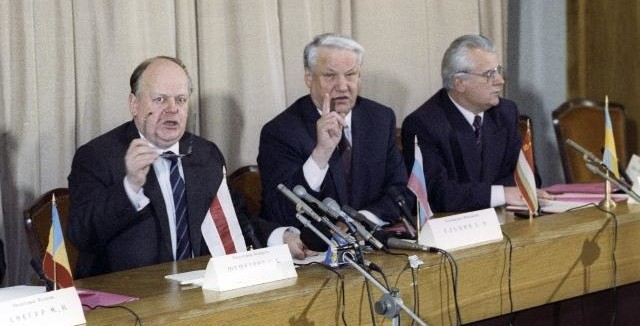
Azerbaijan, Armenia, Kazakhstan, Kyrgyzstan, Moldova, Tajikistan, Turkmenistan and Uzbekistan agreed to join the CIS on December 21 in Almaty, the capital of Kazakhstan. The CIS Charter was adopted on January 22, 1993, in Minsk.
Turkmenistan and Ukraine did not ratify the charter of the organization. For this reason, Turkmenistan has an observer status, Ukraine - a founder. Georgia decided to withdraw from the union in 2008, and Ukraine in 2014.
Currently, the member states of the organization are Azerbaijan, Armenia, Belarus, Kazakhstan, the Kyrgyz Republic, Moldova, Russia, Tajikistan and Uzbekistan.
Azerbaijan became a member of the organization in September 1993 by signing the Charter of the CIS.

The first document on the creation of the CIS, more precisely, the "Agreement on the Creation of the Commonwealth of Independent States", was signed on December 8, 1991. The document, originally signed between Belarus, Russia and Ukraine in Belovezhskaya Pushcha and informally known as the Belovezh Accords, is based on the principles of state sovereignty and territorial integrity. The document states that, based on the common history of the peoples of the Republic of Belarus, the Russian Federation and Ukraine and the relations that have developed between them, their ties are based on mutual recognition and respect for state sovereignty, the right to self-determination, equality and non-interference in internal affairs. They agreed on the creation of the Commonwealth of Independent States, expressing their intention to develop relations on the basis of generally recognized principles and norms of international law without the use of pressure methods.
The parties to the agreement also guaranteed the principles of recognition and respect for each other's territorial integrity and the inviolability of existing borders within the union.
Of course, this point, reflected in the first document, was acceptable to the three post-Soviet countries that signed it. In any case, this issue was already taken into account in the original document.
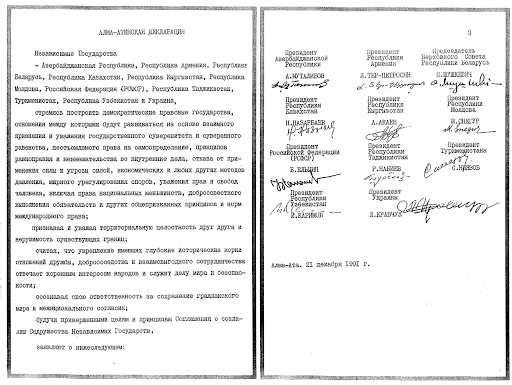
This commitment was further consolidated in the Alma-Ata Declaration of December 21, 1991, which, in addition to Belarus, Russia and Ukraine, was joined by eight more independent republics: Azerbaijan, Armenia, Kazakhstan, Kyrgyzstan, Moldova, Tajikistan, Turkmenistan and Uzbekistan.
The signatories of the Declaration are Azerbaijan, Armenia, Belarus, Kazakhstan, Kyrgyzstan, Moldova, the Russian Federation, Tajikistan, Turkmenistan, Uzbekistan and Ukraine, which strive to create a democratic rule of law based on mutual respect for the principles of non-interference in internal affairs, non-use of force, economic or other methods coercion, peaceful settlement of disputes, respect for human rights and freedoms, including national minorities, full implementation of obligations and other generally recognized principles and norms of international law, the document says.
They also undertook to recognize and respect the territorial integrity and inviolability of each other's borders.
These principles are reflected in the Charter, which is the main document of the CIS. Article 3 of the document again mentions the sovereignty, territorial integrity and inviolability of existing borders.
In 1995, Armenia adopted the law "On the administrative-territorial division of Armenia", A number of changes were made to it in 2009 and approved in July 2010 during the presidency of Serzh Sargsyan. A number of Armenian politicians argue that the law does not cover the demarcation of the border. They note that this document is not enough to clarify the state border, as it defines the borders of various regions of Armenia. However, although the law reflects the administrative division of the regions of Armenia and the regions in which the provinces are united, the border of these regions with Azerbaijan is clearly defined.

Thus, it can be stated that the statements voiced at the rallies in Khankandi are unfounded and do not correspond to reality.




















